|
The Mastery Learning Systems (MLS) Approach - Count (Experience), Notice and, Remember
|
| Getting familiar with things leads to remembering. This is different from memorizing, which is the way first-graders learn the pledge to the flag. They say it over and over until they can say it right, but they don’t know what it means!
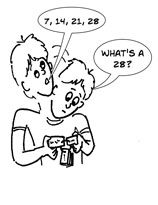
|
|
With Mastery Learning Systems, students
- Discover and Experience concepts, procedures and amounts
- Connect manipulation with computation
- Self-correct
- Build mastery without rote drills or memorization tricks
Think About 4 Weeks
The trip is in four weeks. How many days is that?
| The Experience:
The Concept:
The Math:
|
There are 4 weeks, 7 days in each week, making 28 days altogether
4 Groups, 7 in each group, 28 altogether
4 x 7 = 28
|
This is how we do it:
|
| Middle schoolers in Rohnert Park, CA raised their math diagnostic scores from 58% to 84% after eight hours of after-school instruction using the MLS method. |
|
1. Guide Discovery - rather than explain and model
Teachers, tutors, and parents guide students through a discovery of the concepts which they construct and experience on focused graphics.
|
|
| These "manipulatives" are on paper, so they are cost effective and everyone can construct and experience the math for themselves. Guided by the teacher, students develop a concrete feeling for 4 groups of 7 and can compare that with 5 groups, and 11 groups, and 2 groups of 7.
Once students are oriented to the graphics, this paper manipulative can travel with them to support homework or next week's assignments.
MLS enables students to notice mathematical relationships for themselves and build an accurate mental image or memory of those discoveries. By engaging their active power to notice – not their passive effort to remember what someone else noticed – MLS promotes both thinking skills and math-esteem.
How does MLS use the paper manipulatives?
|
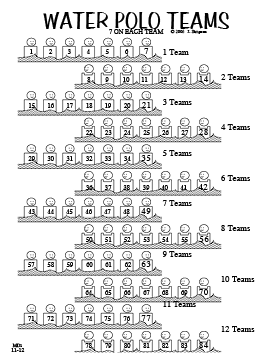 |
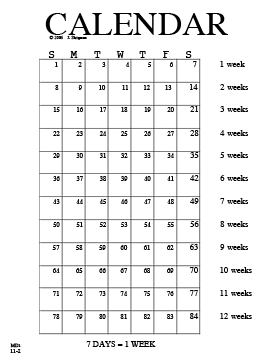 |
2. Connect Manipulation with Computation
While many programs employ manipulatives, graphics, and pictures, MLS follows that experience with specifically sequenced problem pages that enable students to develop context derived fluency constructing, reconstructing, and solving problems with the graphics.
|
|
|
Students are given folding or partner pages, the bottom half having the problems to solve and the top half having the answers. The pages are folded so that only the problems or the answers can be seen from one side. Students pair up with each other, or with a tutor, parent, or teacher and construct each problem on the graphic, 2 weeks = ? days, 4 weeks = ? days and so on down the page. The questions are out of numerical order and cause students to further notice and think about the concept of multiplication - how many in each group, how many groups, and how many altogether.
No answers are given. If a student makes a mistake, the partner simply asks them to try again or to show how they got that answer on the graphic. Students correct themselves. When they get it right, the response is, "good" and they continue on.
|
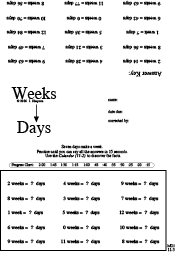 |
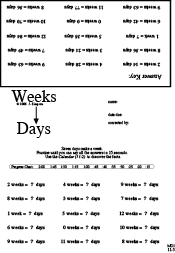 |
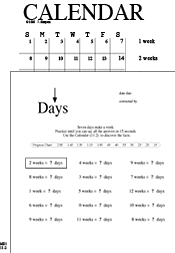 |
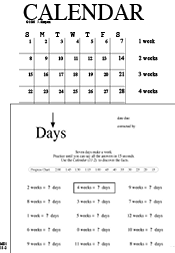 |
Then, there are partner or folding pages of multiplication problems that develop their ability to quickly recall, remember, the multiplication facts they have been experiencing and developing an accurate mental image of.
Students are encouraged at first to construct at least a few of these problems on the graphic page to further the crucial connection between manipulation and computation.
There are a variety of pages that mix and compare multiplication and addition, and present them in different formats to clarify the operations and give more practice.
Division is introduced and developed along with multiplication.
|
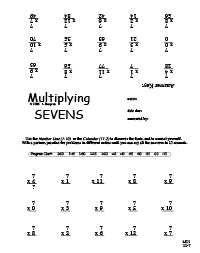 |
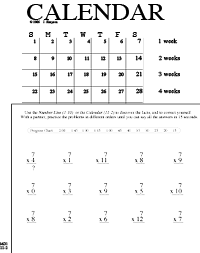 |
 |
| Word Problems
Finally there are word problems that enable students to translate a mini-story into the correct equation and solve the problem.
With the MLS approach, students develop fluency, conceptual understanding, and procedural knowledge. They develop a memory of the 7s by experiencing the 7s. And application is grounded in an understanding of the concept of multiplication - how many groups, how many in each group, how many altogether.
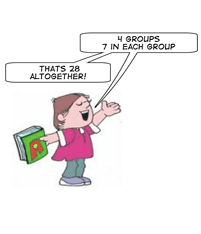
|
|
And the program is easy to implement with any existing curriculum. Use it to:
- quickly introduce a new concept
- quickly follow-up insuring that everyone understands what you just covered in your core program
- quickly review a concept or procedure needed for a later lesson
- have fun that grows naturally out of student accomplishment
|
__________________________________________________________
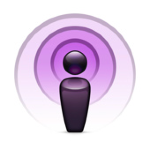 Watch our podcasts, "Soccer Teams" and "The Partner or Folding Pages" to see how MLS employs graphic representations of concepts and procedures in our unique way to support students in their mastery of concepts, facts, and application. Watch our podcasts, "Soccer Teams" and "The Partner or Folding Pages" to see how MLS employs graphic representations of concepts and procedures in our unique way to support students in their mastery of concepts, facts, and application.
Also watch our podcast on "The Progress Chart" to see how to use the chart, shown on the folding pages above, to improve performance without stress and not merely measure it.
|
|
Mastery Learning Systems, 532 N. School Street, Ukiah, CA 95482, 800-533-4181, mastery@pacific.net
|
|